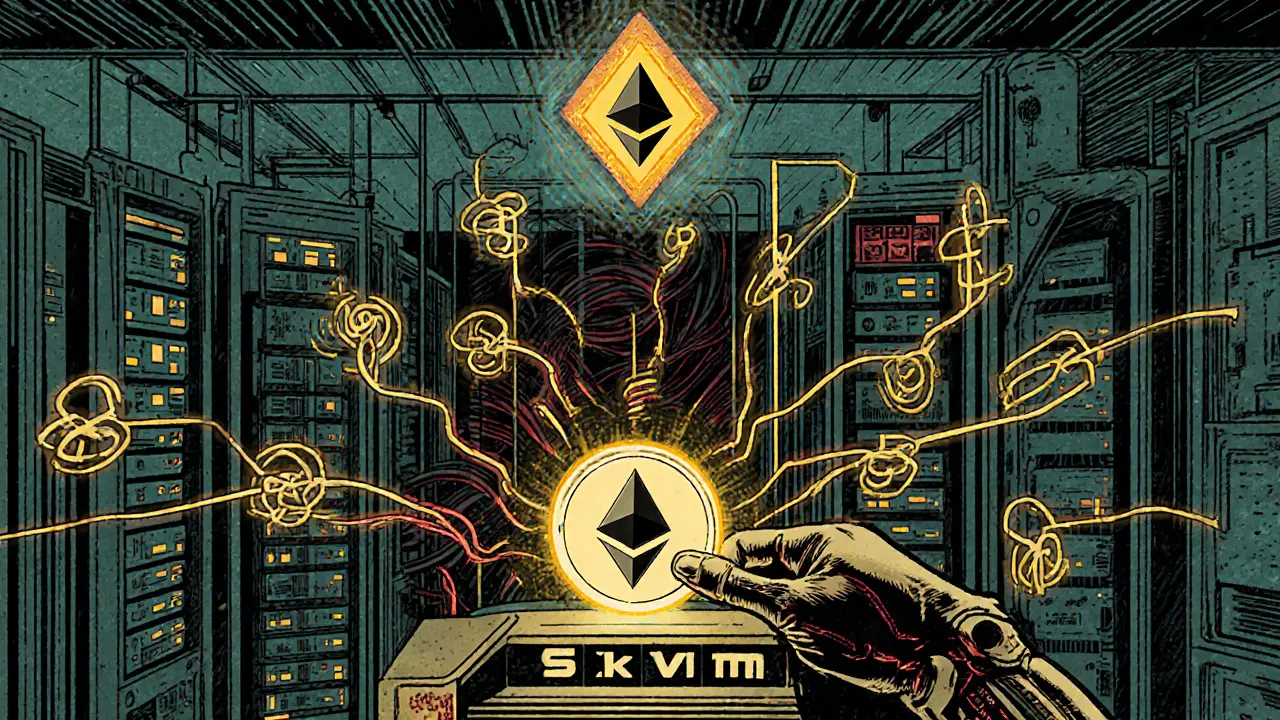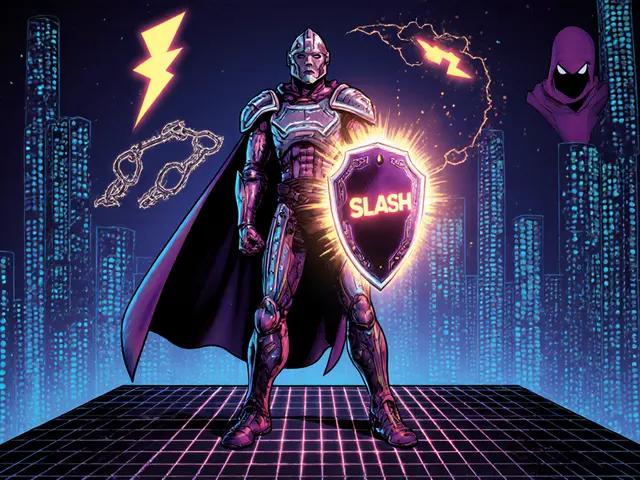
NEX Token Value Calculator
Current NEX Statistics
Current Price:
$0.0003419
Market Cap:
$100,000
Circulating Supply:
210,000,000 NEX
Max Supply:
500,000,000 NEX
Calculate Your Potential Earnings
Projected Earnings Summary
Staking Rewards (Annual):
$0.00
Compute Rewards (Annual):
$0.00
Total Estimated Earnings:
$0.00
Projected ROI:
0%
When you hear the term NEXUS (NEX) is a next‑generation, Ethereum‑compatible blockchain designed to act as a planetary‑scale supercomputer, you might wonder how it differs from the hundreds of other coins floating around. In short, NEXUS aims to merge decentralized compute power with a low‑cost, zero‑knowledge virtual machine (zkVM) that lets anyone - from GPU farms to a single smartphone - contribute processing cycles and earn rewards. Below is a deep dive into what the project offers, how its token works, and whether the market sees any real upside.
Quick Summary
- NEXUS (NEX) is an Ethereum‑compatible chain built around a zkVM for verifiable, low‑fee compute.
- Token supply is capped at 500million NEX, currently trading around $0.00034.
- Funding includes a $25M SeriesA led by Pantera Capital.
- Testnet Phase2 saw over 2million users and 3.6million nodes in five days.
- Market sentiment is mixed: neutral Fear & Greed index, bearish price forecasts for 2025.
What NEXUS Actually Is
The project, developed by Nexus Labs, envisions a "world supercomputer" where idle CPUs, GPUs, and even mobile processors become part of a single, scalable network. By bundling these resources, developers can off‑load AI training, inference, or other heavy workloads without relying on centralized cloud providers. The underlying blockchain is 100% EVM‑compatible, meaning any smart contract written for Ethereum runs unchanged on NEXUS.
Why does the team need a custom chain if it already runs on Ethereum? The answer lies in the zkVM. Traditional EVM transactions require each node to process every computation, which is both slow and costly. The zkVM uses zero‑knowledge proofs to compress millions of off‑chain calculations into a single proof that the network can verify quickly. This enables "Proof Singularity" - a single proof system that can validate any compute job, from DeFi swaps to AI model training.
How the NEX Token Works
The native token, NEX, fulfills three core roles:
- Staking: Providers lock NEX to secure the network and earn a share of transaction fees.
- Gas Payments: Unlike most blockchains that require a native token for gas, NEXUS lets users pay fees with any standard ERC‑20 token, thanks to its priority‑fee mechanism.
- Incentives for Compute: Contributors earn NEX proportional to the amount of verified work their nodes deliver.
The token contract lives at 0xc01154B4CCB518232D6bbfC9B9E6C5068B766f82 on Ethereum, with a hard cap of 500million NEX. As of October2025, circulating supply sits near 210million, pushing the market‑cap below $100k - a tiny slice of the crypto pie.
Technical Architecture at a Glance
Three pillars define NEXUS's technical stack:
- zkVM: Enables batch verification of billions of compute steps with a single proof, dramatically reducing on‑chain data.
- Constant Low Gas: Fees are set to a flat rate (≈$0.00001) regardless of transaction complexity, encouraging mass adoption.
- Priority Fee Model: Users can attach a small extra fee to accelerate their transaction, similar to Ethereum's tip system but without needing NEX for the base fee.
Because the chain mirrors the Ethereum Virtual Machine, developers can leverage familiar tools - Remix, Hardhat, Metamask - without learning a new language. The only new element is integrating the zkVM verification step, which Nexus Labs supplies as a simple SDK.

Market Performance & Price History
According to LiveCoinWatch, NEXUS ranks around #9,270 by market cap. The price peaked at $0.06409 on 13March2024, then tumbled to a low of $0.0001329 on 7April2025 - a 99.5% drop from the all‑time high. The current price (≈$0.0003419) shows a modest 3.19% rise in the last 24hours, but daily volume stays under $50k, indicating thin liquidity.
Technical indicators paint a cautious picture: the 14‑day RSI sits at 43.3 (near oversold), and the price trades below the 50‑day SMA of $0.000358. CoinCodex projects a 25% decline to $0.000248 by December2025, while the Fear & Greed Index reads a neutral 50.
Community Adoption & Real‑World Use Cases
Testnet Phase2 proved the concept is more than hype. Over 2.1million unique users registered, launching 3.6million nodes in just five days. This rapid onboarding suggests developers find the SDK approachable and that casual users are willing to contribute idle compute for NEX rewards.
Potential use cases include:
- AI model training for startups lacking expensive GPU clusters.
- Scientific simulations that need burst compute power.
- Decentralized video rendering for NFT creators.
However, the limited number of exchange listings (Bybit, a few DEXes) curtails broader market exposure. Without deeper liquidity, large holders may hesitate to move significant funds, keeping the token in a niche corner.
How NEXUS Stacks Up Against Competitors
| Project | Primary Use | Token Symbol | Max Supply | Unique Feature |
|---|---|---|---|---|
| NEXUS | Planetary‑scale supercomputer | NEX | 500M | zkVM with constant low gas |
| Render Network | GPU rendering for media | RNDR | Unlimited (inflationary) | Earn via marketplace bids |
| Akash Network | Decentralized cloud compute | AKT | 380M | Marketplace for compute rental |
All three aim to decentralize compute, but NEXUS leans heavily into zero‑knowledge proofs and EVM compatibility, making it a potentially smoother transition for existing Ethereum developers. Render focuses on professional rendering pipelines, while Akash targets generic cloud workloads via an auction model.
Future Roadmap & Risks
The next milestones listed by Nexus Labs include:
- Live mainnet launch for production‑grade AI workloads (Q12026).
- Integration with major AI frameworks like TensorFlow and PyTorch.
- Expansion of node incentives to include stable‑coin rewards.
Key risks remain:
- Liquidity: Thin trading could deter institutional interest.
- Adoption Gap: Moving from testnet demos to paid AI jobs is still unproven.
- Regulatory Uncertainty: Distributed compute may attract scrutiny around data privacy and export controls.
Funding from Pantera Capital (SeriesA) gives the project a $27M runway, but capital alone won’t guarantee network effects. Sustainable tokenomics depend on a healthy balance between compute providers (who stake NEX) and compute consumers (who pay fees).
Should You Consider NEXUS?
If you’re a developer already comfortable with Solidity and need a low‑cost compute layer for AI experiments, NEXUS offers a compelling stack - especially because you can pay gas with any ERC‑20 token. For traders, the market’s thin depth and bearish price outlook suggest caution; entering at current levels could be speculative.
Ultimately, the coin’s value hinges on whether the testnet hype translates into revenue‑generating AI jobs. Keep an eye on mainnet milestones and real‑world partner announcements before allocating a sizable portion of your portfolio.

Frequently Asked Questions
What makes NEXUS different from other blockchain compute projects?
NEXUS combines full EVM compatibility with a zero‑knowledge virtual machine (zkVM) that lets developers run any Ethereum smart contract while paying constant, low gas fees in any ERC‑20 token. This mix of familiarity and cheap compute sets it apart from Render (which focuses on rendering) and Akash (which uses an auction marketplace).
How can I earn NEX tokens?
You earn NEX by running a node that contributes verified compute power. Staking NEX also grants a share of transaction fees and priority‑fee rewards.
Is NEXUS ready for production use?
As of October2025 the network is still in testnet Phase2. The team plans a production‑grade mainnet launch in early 2026, so most real‑world AI workloads are not yet supported.
Where can I buy NEX?
NEX is listed on Bybit and a handful of decentralized exchanges. Because volume is low, expect wider spreads and limited order‑book depth.
What is the long‑term outlook for the NEX token price?
Analysts at CoinCodex forecast a bearish trend, projecting a 25% drop by the end of 2025. Price recovery hinges on mainnet adoption and real AI workloads generating sustainable token demand.






There are 13 Comments
Kimberly M
Thanks for the thorough breakdown, it really helps to see the numbers laid out clearly 😊. I appreciate the neutral tone and the way you highlighted both the tech potential and the market risks. The low gas fees and zkVM sound promising for developers who want to keep costs down. At the same time, the thin liquidity is a red flag for anyone thinking about larger trades. Overall, a solid primer for folks new to NEXUS.
Navneet kaur
you cant trust any of this its just hype i cant even read the math its to hard. someones rly trying to sell a dream not a real project
Marketta Hawkins
Look, America leads in tech, so any project that promises a "planetary supercomputer" should be backed by US talent, not some overseas startup. The specs sound cool, but until they prove real use‑cases you’re just buying hype. 😒
Drizzy Drake
Honestly, the idea of a blockchain‑based compute layer is fascinating and could unlock a lot of untapped potential for developers who are tired of paying exorbitant cloud fees. The zkVM approach, if it lives up to its claims, would let anyone validate massive workloads with a single proof, which is a huge efficiency boost. That said, the current market cap of under $100k indicates that very few people have actually put money behind the vision yet. I think early adopters need to look beyond the hype and ask whether there will be real demand for decentralized AI training. The testnet numbers are impressive-millions of users and a few million nodes in just a few days-but converting those numbers into paying customers is a whole different ballgame. We also have to consider the competition; projects like Akash and Render are already building ecosystems and have more exchange listings. If NEXUS can secure partnerships with AI firms, that could be a game‑changer. The roadmap promises a production mainnet in early 2026, which feels optimistic given the current pace of development. Regulatory scrutiny is another factor-distributed compute could attract data‑privacy concerns that may slow adoption. On the tokenomics side, the dual role of NEX for staking and compute rewards is clever, but the flat gas fee model might limit revenue streams unless they find ways to monetize high‑volume compute jobs. Overall, I’m cautiously optimistic: the tech looks solid, but the market traction needs to catch up before I’d consider a sizeable investment.
AJAY KUMAR
The whole "planetary supercomputer" thing is overblown, just another buzzword. Still, the drama of it all makes it entertaining.
Reid Priddy
Sure, they say it’s just a testnet, but what if it’s a front for a massive data‑harvesting operation? The "low‑fee" narrative is just a distraction while they collect compute power for unknown purposes. And don’t forget the usual pattern: big promise, tiny market cap, then a pump‑and‑dump. Keep your eyes open, nothing is as innocent as it seems.
Shamalama Dee
Great summary! I particularly liked the comparison with Akash and Render, which helps put NEXUS in perspective. The focus on zero‑knowledge proofs could indeed lower transaction costs significantly. However, the thin liquidity remains a concern for potential investors. It will be interesting to see how the team addresses exchange listings in the upcoming months.
scott bell
so its like a crypto cloud but cheaper i guess. how many people actually need that? not sure it will catch on. maybe some niche devs will try.
vincent gaytano
Ah, the noble quest for decentralized compute-how poetic, how utterly misguided. One must wonder if the architects truly believe that a blockchain can out‑perform traditional data centers. The whole premise feels like a philosophical exercise in futility, wrapped in corporate jargon. Yet we smile and nod, as if the mere mention of "zkVM" solves all our problems. In reality, the ecosystem lacks the critical mass to sustain itself. The future may yet prove that this is just another fleeting meme in the crypto wilderness.
Dyeshanae Navarro
It sounds cool but the idea is hard to follow. You need real projects to test it. If they get more users, maybe it works. I think the price will go down for now.
Matt Potter
Look on the bright side-if the tech works, the upside could be massive! Let’s stay hopeful and keep watching.
Marli Ramos
lol idk, sounds lame 😂
Christina Lombardi-Somaschini
Having considered the preceding analyses, one must, with due deference, acknowledge the multifaceted nature of the NEXUS proposition; indeed, its technical underpinnings, namely the zkVM, present a noteworthy advancement in blockchain scalability. Moreover, the comparative assessment against peers such as Render Network and Akash Network elucidates distinct differentiators, particularly the promise of constant low gas fees and EVM compatibility. Nevertheless, the empirical data-most saliently, the modest market capitalization and limited exchange liquidity-undoubtedly warrants a prudent, measured approach to any prospective allocation. In light of the aforementioned, prospective stakeholders are advised to monitor forthcoming mainnet developments, as well as tangible adoption metrics, before forming a definitive investment thesis. Finally, it is incumbent upon the community to foster transparent discourse, thereby ensuring that optimism remains tempered by rigorous scrutiny.
Write a comment
Your email address will not be published. Required fields are marked *